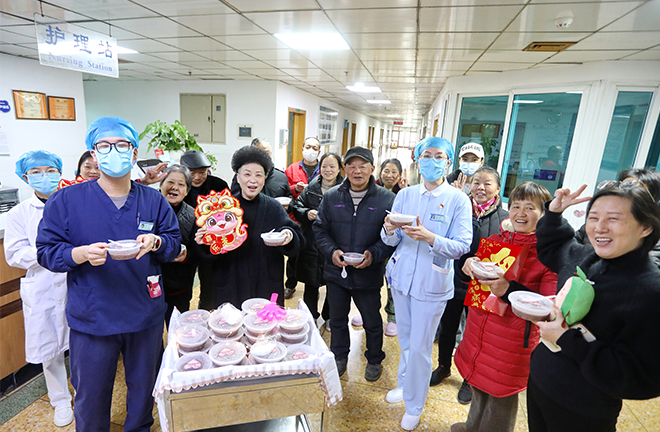Hospital ethnography and its development in China

On January 7, 2025, nurses at a hospital in Jiaxing, Zhejiang Province, serve Laba congee to patients and their families. Photo: IC PHOTO
Modern hospitals are both sites of scientific advancement and spaces fraught with risks. As institutions that address life’s inevitabilities—birth, aging, illness, and death—they create an atmosphere distinct from everyday life, often evoking a sense of cultural and psychological estrangement. This dual nature—both close and distant, familiar yet alien—grants hospital ethnography academic significance and legitimacy.
Pioneering studies in hospital ethnography date back to the mid-20th century. However, as modern hospitals became more standardized and professionalized, conducting fieldwork within them grew increasingly difficult. Nevertheless, over the past two decades, a substantial body of hospital ethnographies based on field research, along with critical essays on the subject, have emerged both in China and abroad, signaling a potential revival of fieldwork-based hospital ethnography.
Theoretical orientations
Hospital ethnography generally follows two theoretical orientations. The first views hospitals as highly structured, self-contained institutions with distinct spatial and institutional arrangements, separate from everyday life. The second orientation challenges the notion of hospitals as “isolated islands,” arguing instead that they are integral parts of the broader sociocultural “mainland,” embedded in wider political and economic structures. From this perspective, hospitals function as microcosms that reflect the underlying logic of social systems.
Since the 1960s, the global expansion of biomedicine has led to the proliferation of modern hospitals beyond developed countries, integrating them into urban landscapes worldwide. This expansion has made hospitals central to people’s everyday experiences, necessitating research that examines hospitals both as significant institutional spaces and in relation to local societies. Three main research approaches explore the connection between hospitals and local contexts. The first explicitly rejects the notion of hospitals as closed systems, emphasizing instead how their forms are deeply shaped by sociocultural factors. The second regards hospitals as microcosms of local society, reflecting core social issues. The third broadens the conceptualization of hospital spaces, viewing them as arenas where objects and subjects are socially (re)arranged.
Indigenous exploration
With the rapid development of medical anthropology and medical sociology in China, hospitals have drawn increasing attention from Chinese social scientists. A number of influential hospital ethnographies have been published, showcasing Chinese characteristics in their agenda-setting and central concerns. A review of China’s indigenous hospital ethnography reveals several notable features.
First, many Chinese hospital ethnographers emphasize ethical considerations, often detailing their review processes and adherence to ethical principles in their methodological discussions. Second, gaining research access is typically relationship-based, with scholars relying on personal connections to enter hospital settings. Third, in addition to ethnographies undertaken in general hospitals, a large number of studies are conducted in a diverse range of medical institutions, including community hospitals, clinics, specialized hospitals, integrated medical and elderly care facilities, and nursing homes. Fourth, research perspectives also vary: sociologists tend to analyze hospital dynamics within broader institutional and structural contexts, whereas anthropologists often highlight ethnography’s strengths in cross-cultural comparison.
Despite these advancements, the uniqueness of Chinese hospitals remains relatively underexplored in China’s hospital ethnography, necessitating focused attention in the following areas.
First, research on hospitals from other disciplines, particularly hospital history, should be incorporated into hospital ethnography. Familiarity with hospital history helps researchers identify which characteristics of hospitals have become taken for granted, which remain deeply ingrained in public consciousness, and which have changed over time.
Second, it is essential to recognize how Chinese hospitals—especially public hospitals—differ from their Western counterparts in terms of organizational systems and institutional structures. Without a firm grasp of these fundamental differences, it is difficult to accurately analyze internal power structures, management mechanisms, personnel systems, and the relationships between hospitals, doctors, and the state.
Third, hospital ethnography should draw upon and contribute to ethnographic studies of other types of organizations and institutions.
Hospital ethnography in China has just begun to flourish. While it should continue to build upon the research findings and analytical frameworks provided by the international academic community, it should also remain attuned to the historical evolution of Chinese hospitals, their internal dynamics, as well as their relationships with both the state and the public. In doing so, China’s hospital ethnography can not only advance academic inquiry but also contribute meaningfully to public health and well-being.
Yu Chengpu is a professor from the School of Sociology and Anthropology at Sun Yat-sen University.
Edited by WANG YOURAN
